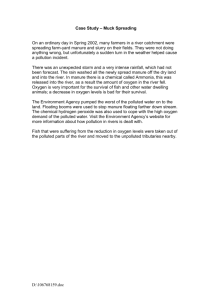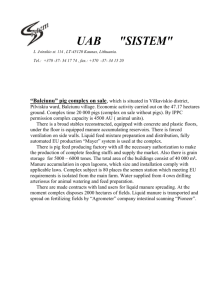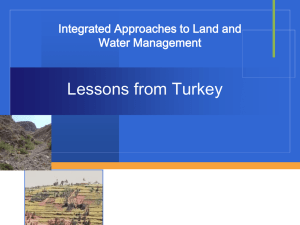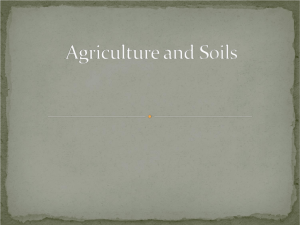Changes in agricultural biodiversity: implications for sustainable livelihood in the Himalaya
advertisement
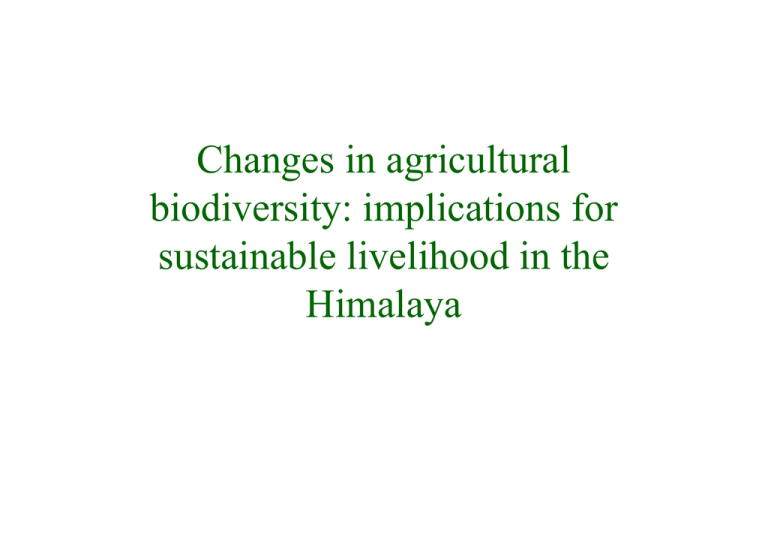
Changes in agricultural biodiversity: implications for sustainable livelihood in the Himalaya Indian Himalaya Settled farming Reserve forests Protected forests Civil forests Multipurpose tree-crop mixed rainfed system Forests and meadows Cultured landscape Agricultural system Community forests Pure crop rainfed system Fruit tree-crop mixed irrigated system Pure crop irrigated system Shifting agriculture Home gardens Ecosystem differentiation in the landscape Terracing Fallowing Extrent of agricultural landuse/forest land use Irrigation management Choice of Crops Traditional Biodiversity management Household decisions - farm/plot scale actions Transhumance Community decisions - landscape scale actions Forest management Manuring regime Irrigation intensity Response to climatic uncertainty Relative emphasis on pure/mixed cropping Size and composition of livestock holdings Spatial dimension of traditional biodiversity management in Central Himalaya. Climate: uncertainty and variability Geomorphology: opportunities and constraints Bio-physical domain Policy domain Land rights Resource rights and concessions Management goals Responsibilities Land use - land cover dynamics Manure and human resource Socio-economic domain Inaccessibility and isolation Local production based: food security Socio-cultural change: subsistence to market economy Soon after first showers in April/May Sowing of two cultivars of barnyard millet (Muatha, Bhagan) and two cultivars of fingermillet (Jhalarya, Chauras) as monocrops Monsoon (high and continuous rainfall) start by mid-June: Ploughing of remaining fields Delayed monsoon: ploughing of remaining fields and sowing of all cultivars of millets Sowing of maize Normal growth of maize Soyabean and Mugeri Kuad cultivar of fingermillet intercropped Poor growth of maize till 20 days after sowing Fields are ploughed afresh and Mungeri Kuad cultivar of finger millet is sown Cropping pattern as determined by climatic conditions in a mid-altitude village Crops Food crops Amaranthus paniculatus Brassica campestris Echinochloa frumentocea Eleusine coracana Fagopyrum esculentum Fagopyrum tataricum Glycine max Hordeum himalayens Hordeum vulgare Pennisetum typhoides Panicum miliaceum Phaseolus lunetus Phaseolus vulgaris Pisum sativum (Var.2) Solanum tuberosum Setaria italica Triticum aestivum Near core zone and low altitude % of total Increased (+) cropped area in decreased (-)/no 1995 (n = 117) change (o) of total cropped area between 1970 - 75 and 1995 (n = 46) (%) (%) 4.4 0.6 a 0 0.6 7.7 a 8.2 a 0 5.6 a 4.0 0 0.6 a 14.6 a 6.0 a 0.3 a 6.6 a 0 21.3 +36 0 -100 -10 0 -19 a -100 -41 a -28 a -100 -82 a +43 a +40 a -28 a +97 a -100 +13 Monetary Value (n=10) (US$/ha) 289±31 519±37 a 311±28 337±21 a 343±30 a 235±s27 a 247±24 268±27 a 549±62 a 906±27 a 547±55 a 805±81 a 265±29 Away from core zone and high altitude Monetary value % of total Increased (+) decreased (-) /no (n=10) cropped change (o) of area in 1995 (n=42) total area between 1970-75 and 1995 (n = 17) (US$/ha) (%) (%) 3.1 b 0 16.3 b 2.3 b 0 8.1 a 0 0 2.5 b 8.6 b 8.9 a 2.3 b 31.3 b 0 0 0 0 0 -30 -76 b 0 -60 b -100 b 0 -79 a +68 a +143 b -50 b +650 b 0 - 494±34 a 503±27 b 474±28 b 239±15 a 310±27 a 626±63 a 969±82 a 647±44 a 1048±28 b - Medicinal plants Allium humile Allium stracheyi Angelica glavacai Carum carvi Dactylorhiza hatagirea Megacarpaea polyandra Pleurosperum angelicoides Saussurea costus 0.9a 0.9a - -7a -6a - 846±79a 502±48a - 2.3b 1.2a 0.3 0.3 0.2 0.2 0.2 -7a -13a +100 +100 +100 +100 +100 945±87a 560±87a 544±57 971±85 786±80 272±19 627±60 - - - 0.3 +100 690±68 Soil loss from different crops grown on varied terrace slopes in the Pranmati watershed, Indian central Himalya. Crop Eleusine coracana Amaranthus paniculatus Echinocloa frumentacea Oryza sativa Solanum tuberosum Soil loss from terrace slope (t ha-1 yr-1 ) Medium (2-60) High (6-100) Low(<20) 1993 1994 1993 1994 1993 1994 0.658 0.089 1.199 0.386 6.037 0.525 0.517 0.372 1.462 0.437 13.435 1.475 0.536 0.093 1.213 0.310 7.578 0.652 0.300 0.334 2.950 0.429 8.122 1.050 0.606 0.327 7.653 1.812 64.400 3.758 Farmyard manure (FYM) input (t/ha/year), fodder yield (t/ha/year) and monetary return (Thousand Rs./ha: Rs. 34 = US$ 1 in 1994-95) across elevation zones in Pranmati watershed, India. FYM/Fodder 1100 –1850 m 1850-2400m Manure input Fodder yield Monetary return 1963 15.0 5.0 21.3 1963 18.3 3.3 27.9 1993 16.5 4.3 34.2 1993 27.4 2.1 52.5 2400-2600m 1963 16.8 1.5 36.8 1993 32.4 0.2 77.3 Important characteristics (mean ± standard deviation, n = 5) of oak-based and pine-based organic manure. Mean values of the two manure types are significantly (P<0.05) different if followed by a different superscript letter. Characteristic Moisture (%) Carbon (%) Nitrogen (%) Cellulose (%) Lignin (%) Polyphenol (%) C/N Lignin / N Polyphenol + Lignin/Nirtogen Manure type Oak 226.21± 19.21a 24.66 ± 0.58a 1.40 ± 0.03a 12.33 ± 0.57a 14.01 ± 1.05a 0.32 ± 0.04a 17.68 ± 1.25a 10.04 ± 0.71a 10.26 ± 0.72a Pine 303.50 20.50b 33.33 ± 0.58b 1.16 ± 0.03b 17.00 ± 2.64b 17.33 ± 0.29b 0.37 ± 0.03b 28.73 ± 0.48b 14.94 ± 0.25b 15.26 ± 0.25b Biomass production (mean ± SD, g m–2) of wheat crop on a sandy soil treated with oak based and pine based manure (@ 10 t ha-1). Two treatments are significantly (P < 0.05) different for all parameters. Component Manure type ________________________________________________ Oak based Pine based Grain 58.5 ± 3.8 46.7 ± 2.7 Straw 108.8 ± 12.1 81.7 ± 5.6 Roots 8.5 ± 0.6 7.3 ± 0.1 Total 175.8 ± 11.6 135.7 ± 9.8 ________________________________________________________________________ 1600 1400 -1 Grain yield (kg ha ) 1200 Wheat Mustard Lentil 1000 800 600 400 200 0 Unlopped 25% 50% 75% 100% Lopping regime Yield of winter season crops grown under unlopped and 25%, 50%, 75% and 100% lopping of agroforestry trees in village Banswara, India. LSD (P=0.05) between means of a crop grown under different lopping regimes are given as vertical lines. Carbon sequestration rate (t ha-1 yr-1) in soil and vegetation after rehabilitation in a low altitude village (Banswara, Chamoli) and a high altitude village (Khaljhuni, Almora ) villages in Indian Central Himalaya. Characteristics Carbon sequestration Banswara Khaljhuni Soil (0-15 cm) Tree bole/bamboo culm Total 2.2 0.9 3.4 4.3 3.1 7.7 Traditional agriculture-forest integrated management Nature: Perverse/tolerant The sacred, Protected area, Hugging the tree movement Nature ephemeral People/Policy responses Nature capricious Nature - benign Cash crops, Profit maximization
